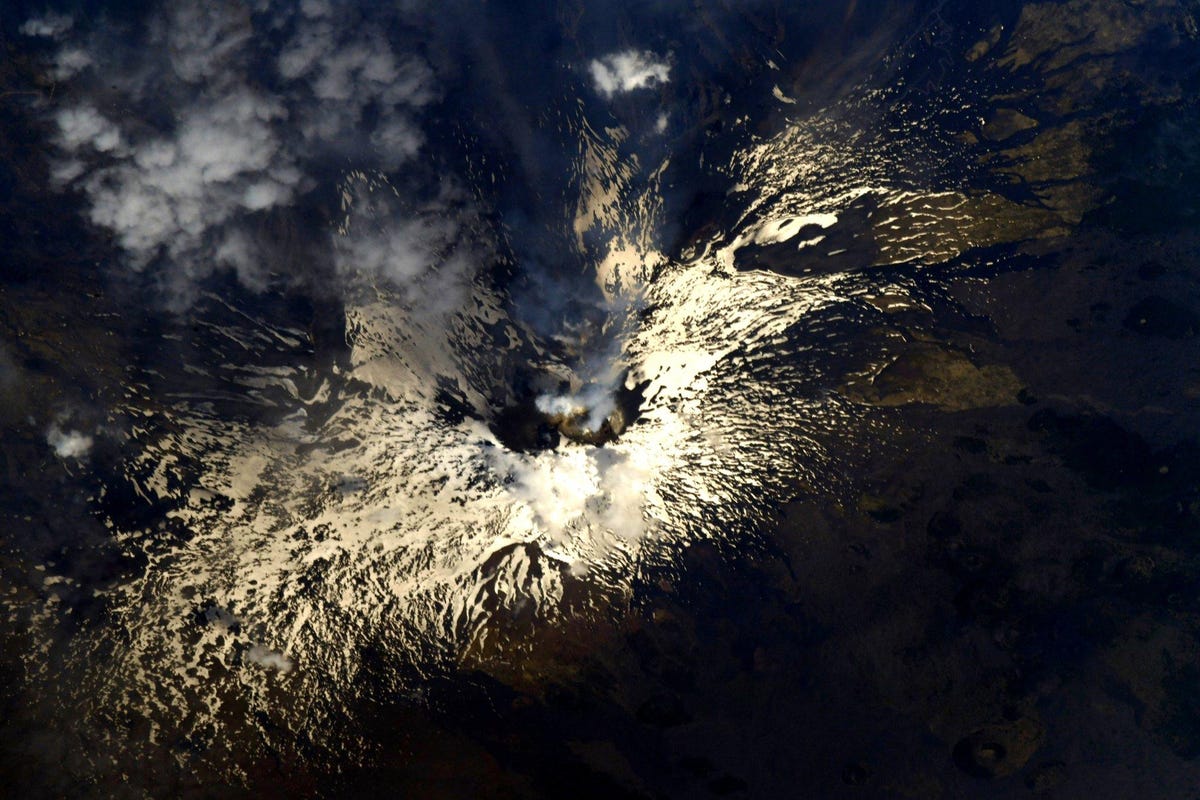Fury from afar: NASA sees violent volcanoes from space
NASA satellites, astronauts and spacecraft get a very different view of fiery volcanoes, ash plumes and lava. But Earth isn't the only volcanic planet.

Mount Etna
Our most familiar images of volcanoes come from views of towering cones belching lava and ash, but the scene from space looks quite a bit different. NASA has captured some spectacular looks at volcanoes over the years, putting these dangerous natural wonders into a new perspective for those of us down on Earth.
NASA astronaut Ricky Arnold posted this dramatic view of Italy's famously active stratovolcano Mount Etna in May 2018. It shows off his photography skills and the ability to capture incredibly detailed images from orbit on board the International Space Station.
Arnold describes the volcano as a "smoldering cauldron."
Kilauea Volcano
The Advanced Spaceborne Thermal Emission and Reflection Radiometer (ASTER) on NASA's Terra satellite picked up this eye-popping image of the Kilauea Volcano in Hawaii in early May. The thermal infrared view shows a series of lava and gas-spewing fissures.
In this image, red is plant life, dark areas show old flows and bright yellow spots indicate fissures and new lava.
Sarychev Volcano
On June 12, 2009, the International Space Station happened to be flying over the Sarychev volcano on Russia's Kuril Islands just as it began to erupt. "The smooth white cloud on top may be water condensation that resulted from rapid rising and cooling of the air mass above the ash column," says NASA.
Shiveluch volcano
This otherworldly view of Russia's Shiveluch volcano comes courtesy of NASA's Earth-watching Terra satellite. The washed-out bright spots are clouds surrounding the plume of ash from the volcano's eruption in mid-2017.
Russian volcano from afar
This ash cloud spewed out of the Shiveluch Volcano on Russia's Kamchatka Peninsula in 2007, reaching a height of about 9,750 meters (32,000 feet). The stark view of the eruption and hovering clouds comes from NASA's Aqua satellite.
The space agency says Shiveluch is "one of the peninsula's most active volcanoes, with an estimated 60 substantial eruptions in the past 10,000 years."
Olympus Mons on Mars
Meet the largest volcano in the solar system. This color mosaic of the Olympus Mons volcano on Mars comes from NASA's Viking 1 orbiter, which launched in 1975. The massive feature has a diameter of about 370 miles (600 kilometers), roughly the size of the state of Arizona.
Edge of Olympus Mons
This is a closer look at the northern edge of Olympus Mons on Mars where landslides appear to be reshaping the landscape. The cliffs here are over 4 miles (7 kilometers) tall.
Olympus Mons is the largest volcano in the solar system. This view came from NASA's Mars Reconnaissance Orbiter in 2010.
Four volcanoes
The Islands of Four Mountains are found in the Aleutian Island chain. This view comes from the International Space Station in 2013. From left to right, these volcanoes are called Herbert, Carlisle, Cleveland and Tana. Swirling clouds hide their lower reaches. Cleveland is particularly active.
Venus volcano
Venus would be a terrible vacation destination. This computer-generated image shows Sapas Mons, one of many volcanoes on the planet's surface. NASA research released in 2010 points to signs of recent lava flows on Venus. The space agency says this would make Venus "one of the few worlds in our solar system that has been volcanically active within the last 3 million years."
Eruption from orbit
The Cleveland Volcano in Alaska erupted on May 23, 2006 and astronaut Jeff Williams caught a look at it from the International Space Station. "The eruption was short-lived; the plume had completely detached from the volcano summit two hours later," says NASA.
Pluto's ice volcano?
NASA also investigates volcanic activity on other planets. While volcanoes on Earth spew molten rock, this possible ice volcano on Pluto would instead kick out a slush of ice, nitrogen, ammonia and methane.
This image comes from NASA's New Horizons spacecraft, which arrived to study the dwarf planet in mid-2015. It shows a feature called Wright Mons, which scientists suspect may be a massive cryovolcano.
Icelandic lava field
Despite its name, Iceland is home to a lot of fiery activity. This annotated NASA Landsat 8 false-color satellite image shows the Holuhraun lava field. An extensive lava flow from 2014 shows up in bright shades of red, orange and yellow.
A history of moon volcanoes
The moon is pretty quiet these days, but it still bears the signs of a raucous volcanic history. This image from NASA's Lunar Reconnaissance Orbiter shows an unusual deposit researchers are calling an irregular mare patch, which may point to more recent volcanic activity on the moon than previously thought.
By "more recent," scientists are still talking in terms of millions and millions of years, but it's an intriguing line of study.
Alaskan eruption
Mount Pavlof in Alaska kicked out this impressive ash plume in 2013 and astronauts on the International Space Station managed to capture this angled view.
A small plume
The Manam Volcano near the mainland of Papua New Guinea released a small plume in mid-2009. NASA's Earth Observing-1 satellite caught this scenic view of the ash and a collection of surrounding clouds.

